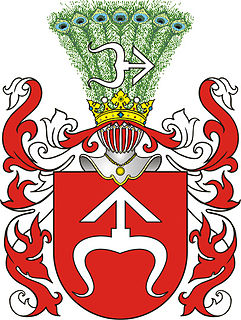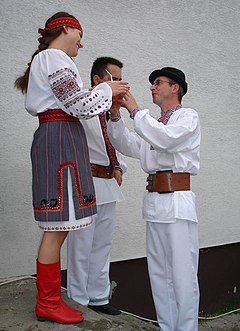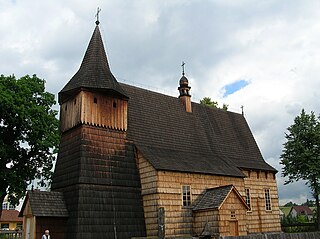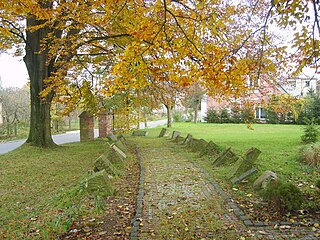| Dominikowice | |
|---|---|
| Village | |
| Coordinates: 49°39′N21°12′E / 49.650°N 21.200°E | |
| Country | |
| Voivodeship | Lesser Poland |
| County | Gorlice |
| Gmina | Gmina Gorlice |
| Population | 2,000 |
Dominikowice [dɔminikɔˈvit͡sɛ] is a village in the administrative district of Gmina Gorlice, within Gorlice County, Lesser Poland Voivodeship, in southern Poland. It lies approximately 3 kilometres (2 mi) east of Gorlice and 102 km (63 mi) south-east of the regional capital Kraków. [1]

A village is a clustered human settlement or community, larger than a hamlet but smaller than a town, with a population ranging from a few hundred to a few thousand. Though villages are often located in rural areas, the term urban village is also applied to certain urban neighborhoods. Villages are normally permanent, with fixed dwellings; however, transient villages can occur. Further, the dwellings of a village are fairly close to one another, not scattered broadly over the landscape, as a dispersed settlement.
Gmina Gorlice is a rural gmina in Gorlice County, Lesser Poland Voivodeship, in southern Poland. Its seat is the town of Gorlice, although the town is not part of the territory of the gmina.

Gorlice County is a unit of territorial administration and local government (powiat) in Lesser Poland Voivodeship, southern Poland, on the Slovak border. It was created on 1 January 1999 as a result of the Polish local government reforms passed in 1998. Its administrative seat and largest town is Gorlice, which lies 100 kilometres (62 mi) south-east of the regional capital Kraków. The only other towns in the county are Biecz, lying 12 km (7 mi) north-east of Gorlice, and Bobowa, 18 km (11 mi) west of Gorlice.
The village has an approximate population of 2,000.
The village belongs to one of the oldest rural settlements in the area, having been endowed by the king on a Polish knight, Dominik Pieniążek (see: Jan Chryzostom Pieniążek, from Odrowąż family(see Odrowąż coat of arms) in 1291. The village has long comprised what is now the villages of Kobylanka, Klęczany and other negligible adjacent areas, until those two became separate nobility's ( szlachta's) estates.

Jan Chryzostom Pieniążek was a Polish szlachcic.

Odrowąż is a Polish coat of arms of probably Moravian origin. It was used by many noble families known as szlachta in Polish in medieval Poland and later under the Polish-Lithuanian Commonwealth, branches of the original medieval Odrowążowie family as well as families connected with the Clan by adoption.

Kobylanka is a village in the administrative district of Gmina Gorlice, within Gorlice County, Lesser Poland Voivodeship, in southern Poland. It lies approximately 5 kilometres (3 mi) north-east of Gorlice and 102 km (63 mi) south-east of the regional capital Kraków.
Unlike most of the neighbouring villages, which before the Operation Vistula (1940s) were largely inhabited by Rusyns' populations (recently called "Lemkos" to avoid inappropriate associating them with any Russian proveniences), throughout the history, Dominikowice and Kobylanka constituted almost homogenously Polish settlement.

Operation Vistula was a codename for the 1947 forced resettlement of the Ukrainian minority as well as Boykos and Lemkos from the south-eastern provinces of post-war Poland, to the Recovered Territories in the west of the country. The action was carried out by the Soviet-installed Polish communist authorities with the aim of removing material support and assistance to the Ukrainian Insurgent Army. The Ukrainian Insurgent Army continued its guerilla activities until 1947 in both Subcarpathian and Lublin Voivodeships with no hope for any peaceful resolution. Operation Vistula effectively brought an end to the hostilities.

Rusyns, sometimes referred to as Rusnaks and also known as Carpatho-Ruthenians or Carpatho-Russians, are an East Slavic people, who speak an East Slavic language known as Rusyn. As a distinctive people, Rusyns descend from East Slavic population that inhabited northern regions the Eastern Carpathians since the Early Middle Ages. Together with other East Slavs from neighboring regions, they were often labeled by common exonym Ruthenians, or by regionally more specific designation Carpathian Ruthenians. Unlike their eastern neighbors, who adopted the use of ethnonym "Ukrainians" in the early 20th century, Rusyns kept and preserved their original name. As residents of northeastern regions of the Carpathian Mountains, Rusyns are closely connected, and also sometimes associated, with other Slavic communities in the region, like the Slovak highlander community of Gorals.

Lemkos are an ethnic group inhabiting Lemkivshchyna, a part of Transcarpathia.








